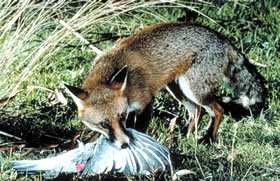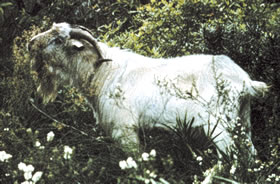The Vortex!
Life is tough for Brush-tailed Rock-wallabies. In the past they were considered pests and were hunted for their skins, contributing to a massive decline in numbers. In 2000 they were declared nationally vulnerable to extinction. Brush-tailed Rock-wallabies face a number of serious threats resulting in colonies gradually blinking out across the landscape. Some of the threats as outlined in the draft National Recovery Plan include:
 Feral fox. Photo: J Cooper – DECCW
Feral fox. Photo: J Cooper – DECCWFeral foxes
The introduction of the red fox has had a major impact on Brush-tailed Rock-wallabies. This is mainly because the wallabies have evolved without the threat of introduced predators and therefore have limited ways to defend themselves against these species. Foxes were introduced into Australia soon after European settlement and are now well established over most of the non-tropical mainland, including Rock-wallaby habitat. They are believed to have contributed to the extinction of several other small mammal species.
Habitat loss and land clearing
Brush-tailed Rock-wallabies have been deprived of available habitat due to a combination of factors including clearing of native vegetation for agriculture and grazing, and changed patterns of fire across the landscape. Residential and tourist developments adjacent to some colonies are causing habitat modification, making it harder for wallabies to find homes.
Often the only remaining habitat is fragmented, small patches of bush that isolates wallaby populations and makes them more prone to stochastic or chance events such as wildfires and drought.
 Feral goat. Photo: DECCW
Feral goat. Photo: DECCWFeral goats, sheep and rabbits
In some areas, Brush-tailed Rock-wallabies have to compete with feral goats, sheep and rabbits for habitat and food. This unnatural competition forces them to search for food outside their natural area, making them more susceptible to predators.
Other predators
Feral cats, wild dogs, and eagles are also known predators to young wallabies and threaten the survival of family groups.
Native predators
Spot-tailed Quoll (endangered) and the Wedge-tailed Eagle are capable of being native predators to the Brush-tailed Rock-wallaby.
Habitat degradation from weed invasion
High densities of certain invasive weeds may reduce the amount of suitable habitat. Although Brush-tailed Rock-wallabies may sometimes snack on lantana and blackberry, they can form a barrier that restrict the wallaby’s access to feeding and shelter areas, pose a fire hazard and out-compete native food.
Disease
Diseases may also cause significant mortality in populations. Small populations mean Brush-tailed Rock-wallabies are more prone to significant risk with a chance event like disease.
State Information
What you can do!
An important aspect of Brush-tailed Rock-wallaby recovery is the active involvement of local landholders and the community overall. See what you can do!
Resources
- Vortex Project Brief
- The Shadow – Newsletter of Brush-tailed Rock-wallaby conservation in Victoria
Did you know?
Rock-wallabies aren’t found anywhere else on earth. There are 16 species of rock-wallaby and they form the largest group of macropods (marsupial with large hind limbs) in Australia.






